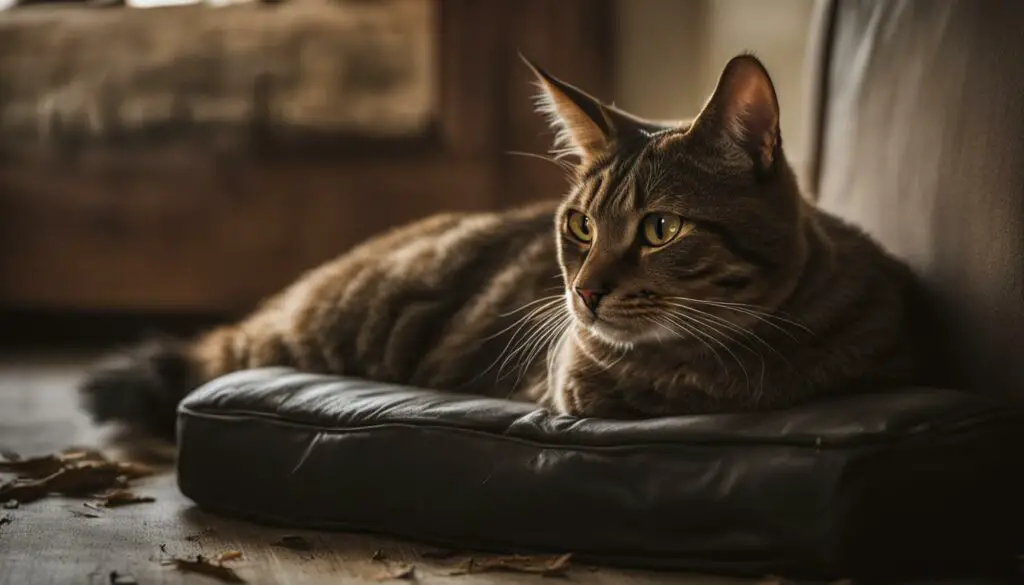As a cat owner, it’s important to recognize that cats can experience separation anxiety, just like humans. Understanding the signs and causes of cat separation anxiety is the first step in helping your feline friend feel more secure and comfortable when you’re not around.
By following these tips and guides, you can ease your cat’s anxiety and create a more calm environment for them:
- Provide plenty of mental and physical stimulation to keep your cat engaged and entertained.
- Create a cozy and safe space where your cat can retreat to when they feel anxious.
- Gradually acclimate your cat to being alone by practicing short periods of separation and gradually increasing the time.
- Consider using pheromone diffusers or calming sprays to create a soothing atmosphere in your home.
- Seek professional advice from a veterinarian or animal behaviorist for additional guidance and support.
Key Takeaways:
- Cats can experience separation anxiety, which can manifest in various behaviors such as excessive meowing and hiding.
- Understanding the causes of cat separation anxiety, such as genetics and early weaning, can help in developing effective strategies to ease their anxiety.
- Behavioral modifications, like providing mental stimulation and creating a safe space, can significantly reduce cat separation anxiety.
- In severe cases, medication prescribed by a veterinarian may be necessary to alleviate a cat’s separation anxiety.
- Proactively addressing and managing cat separation anxiety can lead to a happier and healthier cat.
Do Cats Get Separation Anxiety?
Cats, like dogs, can experience separation anxiety, although it may be less noticeable. While dogs tend to show their anxiety through visible signs such as barking, whining, and destructive behavior, cats may exhibit more subtle signs of separation anxiety. It’s important for cat owners to recognize and address this issue to ensure their furry companions’ well-being.
Research has shown that cats form strong bonds with their owners and can feel anxious and lonely when left alone. They rely on the presence and interaction with their human companions for comfort and security. When they are separated from their owners, they may become stressed and exhibit signs of anxiety.
Symptoms of separation anxiety in cats can include excessive vocalization, changes in appetite, inappropriate elimination, destruction of household items, and excessive grooming. Cats may also become withdrawn or exhibit clingy behavior when their owners are preparing to leave or return home.
Understanding that cats can experience separation anxiety is the first step in providing them with the necessary support and care. By creating a stimulating and enriched environment, employing behavior modification techniques, and seeking professional advice if needed, cat owners can help alleviate their feline friends‘ anxiety and create a more peaceful and harmonious home.
Common Cat Anxiety Signs and Symptoms
Cat separation anxiety can manifest in various signs and symptoms that indicate your feline friend is feeling neglected, depressed, or anxious. It’s important to be aware of these indicators to address your cat’s needs and ensure their well-being. Here are some common signs of cat anxiety:
- Excessive meowing: Your cat may vocalize more than usual, seeking attention and companionship.
- Clinginess: Your cat may become excessively clingy, following you around the house and insisting on constant physical contact.
- Hiding: Your cat may retreat to secluded areas of the house, seeking solitude as a coping mechanism for their anxiety.
- Fearful behavior: Your cat may exhibit signs of fear, such as trembling, crouching, or trying to escape from certain situations.
- Urinating or defecating outside the litter box: Your cat may display inappropriate elimination habits as a response to their anxiety and stress.
If you notice any of these signs in your cat, it’s essential to pay attention and seek veterinary advice. Your veterinarian can provide a proper diagnosis and recommend appropriate measures to help alleviate your cat’s anxiety.
| Signs of Cat Anxiety | Symptoms |
|---|---|
| Excessive meowing | Vocalizing more than usual, seeking attention and companionship |
| Clinginess | Becoming excessively clingy, following you around the house and insisting on constant physical contact |
| Hiding | Retreating to secluded areas of the house, seeking solitude as a coping mechanism |
| Fearful behavior | Exhibiting signs of fear, such as trembling, crouching, or trying to escape |
| Urinating or defecating outside the litter box | Displaying inappropriate elimination habits as a response to anxiety and stress |
It’s important to remember that every cat is unique, and their anxiety symptoms may vary. Some cats may exhibit only a few of these signs, while others may display a combination of them. By closely observing your cat’s behavior, you can better understand their needs and provide appropriate support.
Please note that while these signs may be indicative of separation anxiety, they can also be caused by other underlying medical or behavioral issues. Consulting with a veterinarian is crucial to rule out any potential health concerns and determine the best course of action for your cat’s well-being.
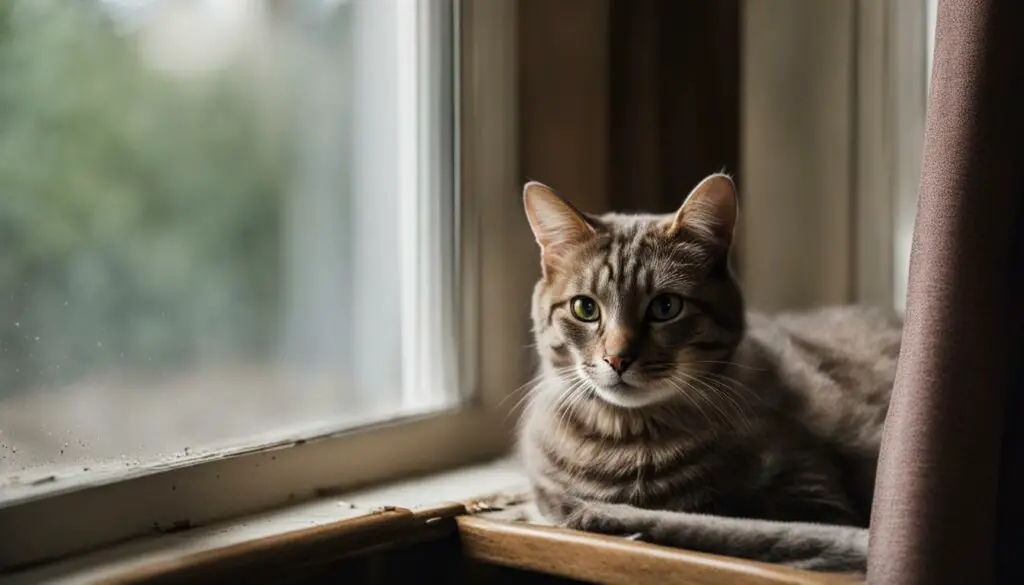
Understand Cat Separation Anxiety Causes
When it comes to cat separation anxiety, there are several factors that can contribute to its development. Understanding the causes is crucial in addressing and managing your cat’s anxiety effectively. Here are some common causes of cat separation anxiety:
- Early Weaning: Kittens that are separated from their mother too early may have a higher risk of developing separation anxiety. The mother cat plays a crucial role in teaching social skills and providing comfort to her kittens.
- Genetics: Some cats are simply more predisposed to anxiety due to their genetic makeup. Certain breeds, such as Siamese or Burmese cats, may be more prone to separation anxiety.
- Lack of Socialization: Cats that have not been properly socialized during their early life stages may struggle with separation anxiety. Socialization helps cats develop confidence and adaptability.
- Change or Lack of Stimuli: Cats thrive in environments that provide mental and physical stimulation. A lack of environmental enrichment or sudden changes in routine can trigger anxiety in cats.
- Health Issues: It’s important to rule out any underlying health conditions that may be contributing to your cat’s anxiety. Medical conditions, such as urinary tract infections or thyroid problems, can manifest as anxiety-like symptoms.
By considering these potential causes, you can better understand your cat’s anxiety and take appropriate steps to address it. Remember, each cat is unique, and what works for one may not work for another. If you’re struggling to manage your cat’s separation anxiety, don’t hesitate to seek guidance from a veterinarian or professional behaviorist.
| Cause | Description |
|---|---|
| Early Weaning | Kittens separated from their mother too early |
| Genetics | Some cat breeds may be more prone to separation anxiety |
| Lack of Socialization | Cats that haven’t been properly socialized as kittens |
| Change or Lack of Stimuli | Environmental changes or lack of mental/physical stimulation |
| Health Issues | Underlying medical conditions that contribute to anxiety |
Understanding the causes of cat separation anxiety is the first step in helping your furry friend. By addressing these underlying factors and providing a supportive environment, you can help alleviate your cat’s anxiety and create a sense of security.
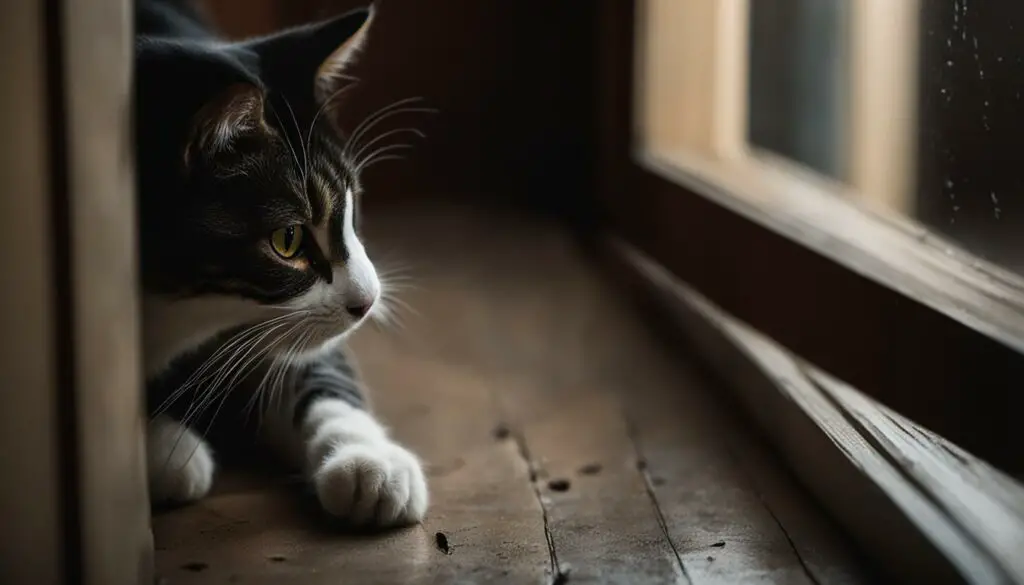
Options of Treatment For Cat Anxiety
When it comes to treating cat separation anxiety, there are various options available. The most effective approach often involves a combination of behavioral modification techniques and, in severe cases, medication prescribed by a veterinarian.
Behavioral Modification
Behavioral modification techniques focus on reducing stress and increasing mental stimulation for cats. This can be achieved through several methods:
- Playtime: Engaging in interactive play sessions with your cat can help alleviate anxiety and redirect their energy.
- Environmental Enrichment: Creating a safe and stimulating environment, including scratching posts, toys, and hiding places, can provide mental stimulation and alleviate boredom.
- Safe Spaces: Creating a cozy space with a comfortable bed or blanket can give your cat a sense of security and help them feel more relaxed.
- Gradual Separation Training: Gradually increasing the time your cat spends alone can help them become more accustomed to being apart from you.
Medication
In severe cases of cat separation anxiety, medication may be necessary. This should always be prescribed by a veterinarian, as they can determine the appropriate dosage and monitor any potential side effects. Common medications used to treat cat anxiety include:
- Anti-Anxiety Medications: These medications help regulate the chemicals in a cat’s brain to reduce anxiety and improve their overall well-being.
- Antidepressants: Similar to anti-anxiety medications, antidepressants can help stabilize a cat’s mood and reduce anxiety.
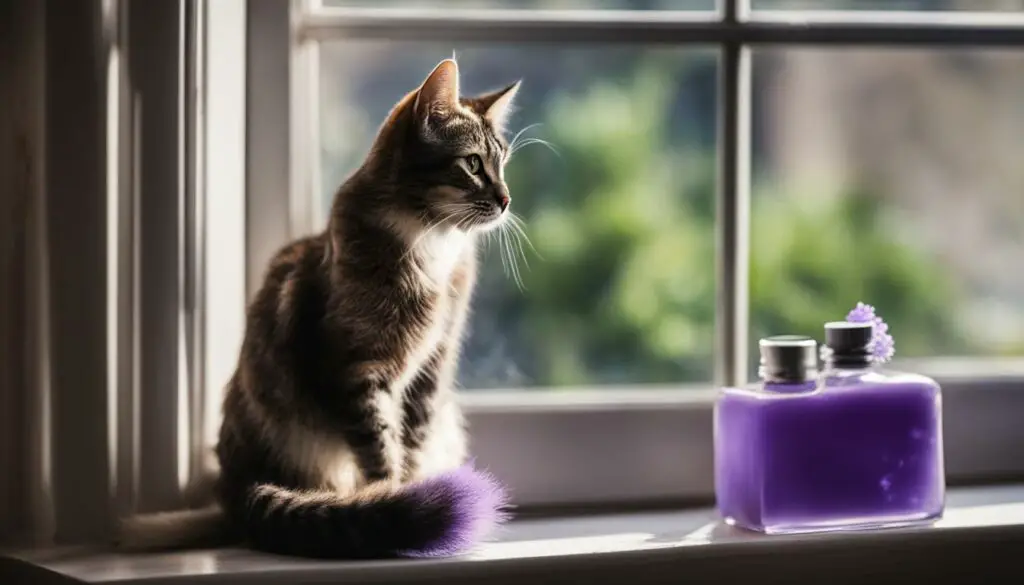
Remember, it’s important to consult with a veterinarian to determine the best treatment options for your cat’s specific needs. They can provide guidance on the most effective techniques and medications to help alleviate your cat’s separation anxiety.
Kittens Separation Anxiety
When it comes to separation anxiety, kittens are not exempt from experiencing this distressing condition. Kittens that were separated from their mother too soon or had a lack of socialization may be more prone to separation anxiety. It’s important for kitten owners to provide them with a safe and stimulating environment, plenty of love and playtime, and gradual separation training to help them adapt. By addressing their anxiety early on, we can help kittens grow into well-adjusted and confident cats.
Separation anxiety in kittens can manifest in various ways, such as excessive crying, destructive behavior, or withdrawal. These signs are indicative of their discomfort and stress when separated from their primary caregiver or familiar surroundings. It’s crucial to create a supportive environment for them and gradually introduce independence to help them develop resilience and coping mechanisms.
One effective method for kittens with separation anxiety is gradual separation training. This involves slowly increasing the time spent apart from the kitten, starting with short intervals and gradually extending the duration. During these periods of separation, it’s essential to provide them with comforting toys, blankets, and other familiar objects that carry the scent of their owner. These items can help alleviate their anxiety and make the transition smoother.
Creating a Cozy Space for Kittens with Separation Anxiety
- Designate a specific area in your home where your kitten feels safe and secure.
- Provide a comfortable bed or blanket for them to snuggle up in.
- Place their favorite toys and a scratching post in the designated area to keep them mentally stimulated.
- Consider using a pheromone diffuser to create a calming environment for your kitten.
Kittens rely on their owners for security and companionship, and it’s our responsibility to help them navigate through separation anxiety. With patience, love, and proper training, we can support kittens in overcoming their anxiety and ensure they grow into happy and well-adjusted adult cats.
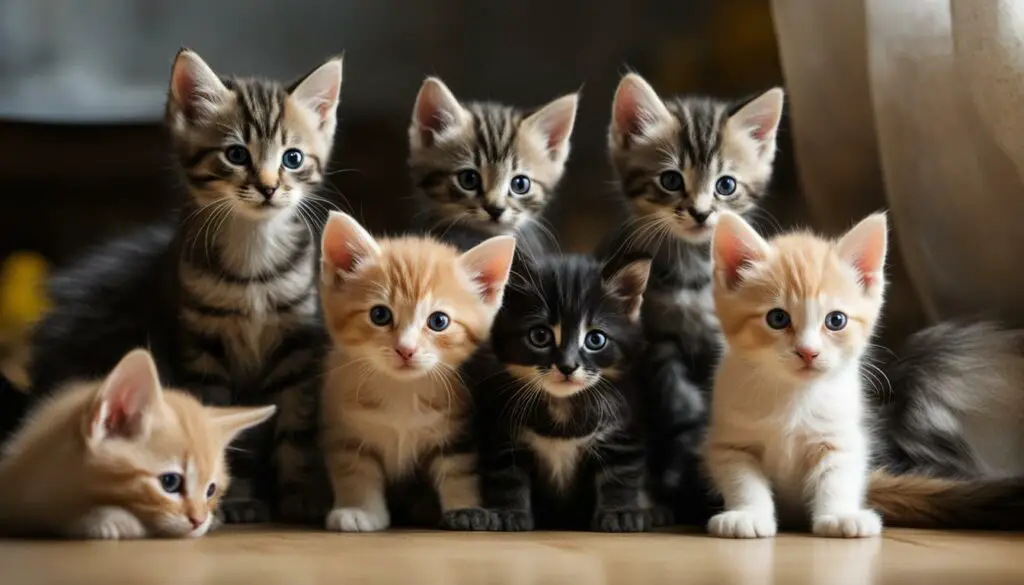
Leaving Cats Alone & Crying Cats
Leaving cats alone can be a challenging experience for both the cat and the owner. Cats, especially those who are strongly bonded with their owners, may exhibit signs of distress, including crying, when left alone. It’s important to understand how to gradually accustom them to being alone and provide them with a comfortable environment to help ease their anxiety.
To minimize your cat’s distress when you leave, create a safe and cozy space for them. This can include a comfortable bed or blanket, along with their favorite toys. Providing a familiar scent, such as an unwashed item of clothing, can also offer comfort and reassurance.
Another useful tip is to de-dramatize goodbyes and hellos. Cats are perceptive animals, and if they sense that you are stressed or anxious when leaving, it can heighten their own anxiety. Instead, maintain a calm and confident demeanor during these transitions, emphasizing a sense of routine and normalcy. Offering treats or engaging in playtime before leaving can help distract your cat and create positive associations with your departure.
| Leaving Cats Alone & Crying Cats Tips |
|---|
| • Create a cozy and safe space for your cat |
| • De-dramatize goodbyes and hellos |
| • Provide treats or engage in playtime before leaving |
| • Consider using pet cameras or treat dispensers |
Additionally, there are innovative tools available that can help ease your cat’s separation anxiety. Pet cameras allow you to keep an eye on your cat while you’re away, providing both reassurance for you and a sense of connection for your cat. Some pet cameras even have interactive features, such as two-way audio or treat dispensers, which can help alleviate your cat’s anxiety by providing stimulation and interaction.
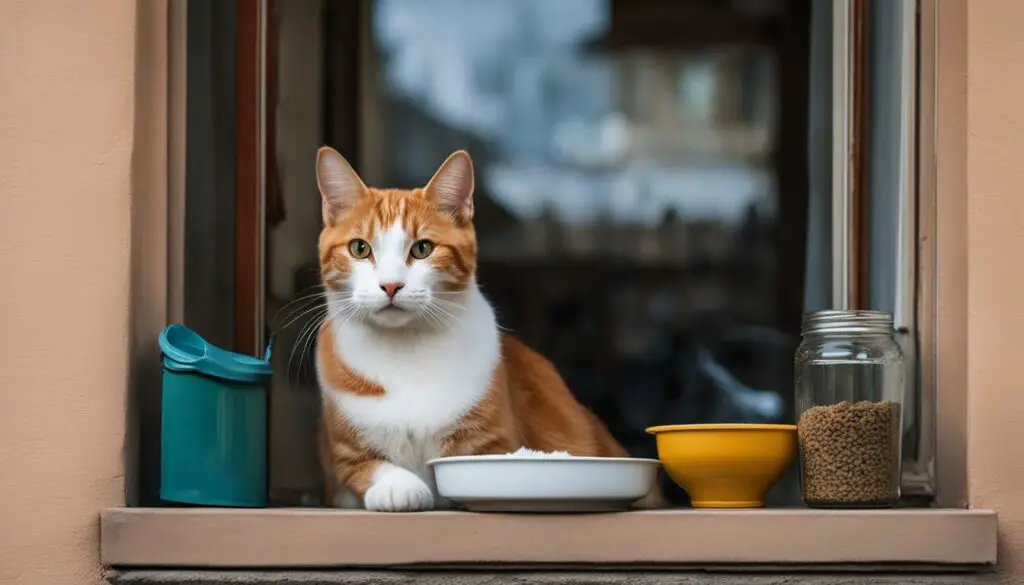
By gradually acclimating your cat to being alone, providing a cozy environment, and utilizing tools such as pet cameras, you can help ease their separation anxiety. It’s important to remember that every cat is unique, and it may take time to find the strategies that work best for your feline companion. Seeking advice from a veterinarian or professional behaviorist can also be beneficial in managing and addressing your cat’s separation anxiety.
Monitor Your Pet
When it comes to easing your cat’s separation anxiety, monitoring your pet can be a helpful tool. Pet cameras provide a way for you to keep an eye on your cat while you’re away, offering both reassurance and peace of mind. These cameras often come with features that allow you to interact with your cat, such as voice communication and treat dispensing, which can help alleviate their anxiety.

By setting up a pet camera, you can observe your cat’s behavior and see how they react when left alone. This can help you gain a better understanding of their anxiety triggers and enable you to take appropriate measures to address them. Additionally, being able to see and interact with your cat through the camera can provide comfort to both you and your pet, strengthening the bond between you.
When using a pet camera, it’s important to remember that it should not replace direct human interaction. While a camera can help ease your cat’s anxiety, nothing beats spending quality time with your pet. Take the time to play, cuddle, and engage in activities that your cat enjoys when you’re home. This will not only help alleviate their anxiety but also contribute to their overall well-being and happiness.
Benefits of Pet Cameras
- Allows you to monitor your cat’s behavior when you’re away
- Enables interaction with your cat through voice and treat dispensing features
- Offers reassurance and peace of mind for both you and your pet
- Strengthens the bond between you and your cat
By utilizing pet cameras as a tool in addressing your cat’s separation anxiety, you can gain valuable insights into their behavior and provide them with the comfort and support they need when you’re not around.
Table:
| Benefits of Pet Cameras | |
|---|---|
| Allows you to monitor your cat’s behavior when you’re away | |
| Enables interaction with your cat through voice and treat dispensing features | |
| Offers reassurance and peace of mind for both you and your pet | |
| Strengthens the bond between you and your cat |
Can Cats Get Separation Anxiety? Explained by Experts!
As a cat owner, I’ve often wondered if cats can experience separation anxiety like dogs do. After doing some research and consulting with experts, I’ve discovered that the answer is yes! Cats can indeed develop separation anxiety, although it may be less common and less noticeable compared to dogs.
Many people believe that cats are independent and aloof creatures, but the truth is that they are social animals that form strong bonds with their owners. When separated from their beloved human companions, cats can experience stress and anxiety.
Experts confirm that cats can exhibit signs of anxiety when left alone. These signs may include excessive vocalization, destructive behavior, inappropriate elimination habits, loss of appetite, pacing, and restlessness. It’s important for cat owners to recognize these symptoms and take steps to help their feline friends cope with separation anxiety.
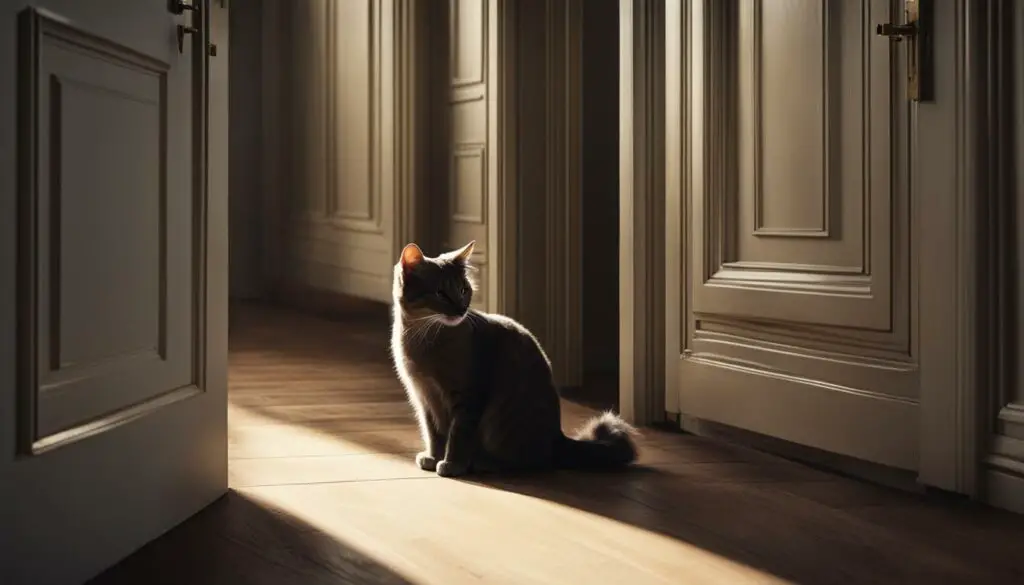
Key Takeaways:
- Cats can experience separation anxiety, although it may be less common compared to dogs.
- Signs of separation anxiety in cats can include excessive vocalization, destructive behavior, and loss of appetite.
- Cats are social animals that form strong bonds with their owners.
- Creating a safe and stimulating environment can help alleviate separation anxiety in cats.
- Consulting with a veterinarian or professional behaviorist can provide guidance on managing cat separation anxiety.
What Is Cat Separation Anxiety?
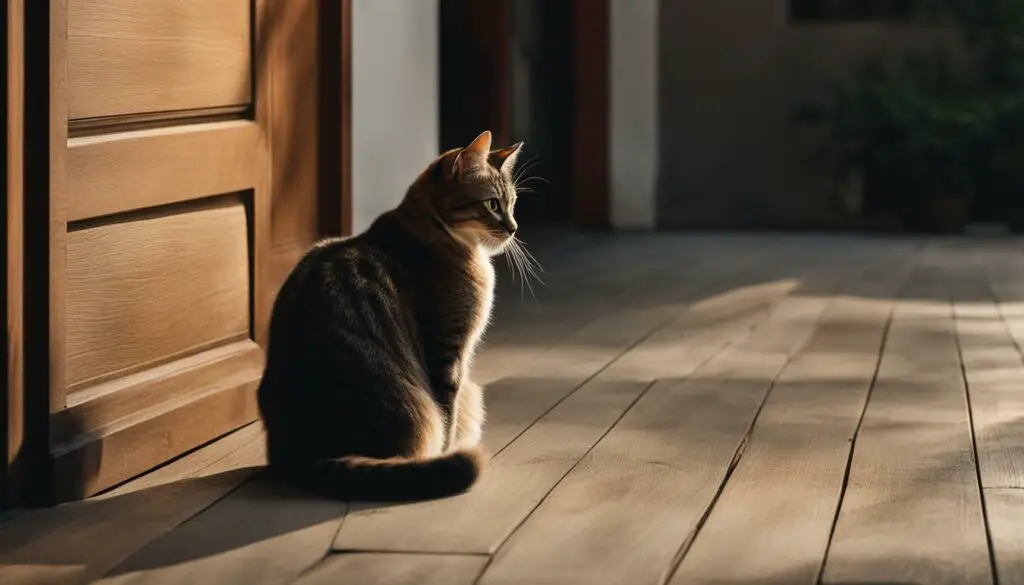
Cat separation anxiety is a common stress response observed in cats when they are separated from someone or another animal they are strongly bonded to, such as their owner. Contrary to the misconception that cats are less social than dogs, research shows that cats are social animals, particularly when it comes to their owners.
When cats experience separation anxiety, they may exhibit various signs of distress, such as excessive meowing, destructive behavior, inappropriate elimination, loss of appetite, and restlessness. These symptoms can vary in intensity and duration depending on the individual cat. It’s important for cat owners to recognize these signs and take steps to address their cat’s separation anxiety.
“Cats can form strong bonds with their owners and can feel anxious and lonely when left alone.”
To help cats cope with separation anxiety, creating a cozy space for them with a comfortable bed or blanket can provide a sense of security. It’s also essential to de-dramatize both goodbyes and hellos to minimize anxiety triggers. Providing mental stimulation through toys, treats, and interactive playtime can help alleviate anxiety and keep their minds occupied. If the symptoms persist or worsen, it is advisable to seek advice from a veterinarian or professional behaviorist who specializes in cat separation anxiety.
Causes of Cat Separation Anxiety
Understanding the causes of cat separation anxiety can help us better address and manage this distressing condition in our feline friends. While the exact causes are not fully understood, it is believed to be a combination of environmental and hereditary factors. Let’s explore these factors in more detail:
| Environmental Factors | Hereditary Factors |
|---|---|
|
Changes in routines: Cats are creatures of habit and sudden changes in their daily routine, such as a new work schedule or moving to a new home, can trigger anxiety. |
Genetics: Some cats may be more predisposed to separation anxiety due to their genetic makeup. Certain breeds, such as Siamese and Burmese, have been found to be more prone to anxiety-related issues. |
|
Lack of socialization: Cats who have not been properly socialized as kittens may have difficulty coping with being alone. Early experiences and exposure to different people, animals, and environments can play a role in their ability to handle separation. |
Early life experiences: Cats that were orphaned or weaned too young may develop separation anxiety later in life. The loss of their mother or littermates at a critical developmental stage can impact their ability to regulate emotions and cope with being alone. |
|
Stressful environments: Cats living in high-stress environments, such as households with constant conflict or noise, may be more susceptible to separation anxiety. A lack of environmental enrichment and mental stimulation can also contribute to their distress. |
Previous trauma: Cats that have experienced traumatic events, such as abuse or neglect, may develop separation anxiety as a result of the unresolved fear and anxiety associated with those experiences. |
It’s important to note that while these factors can increase the likelihood of separation anxiety in cats, not all cats will develop this condition. Every cat is unique, and individual experiences and personality traits can also influence their susceptibility to separation anxiety.
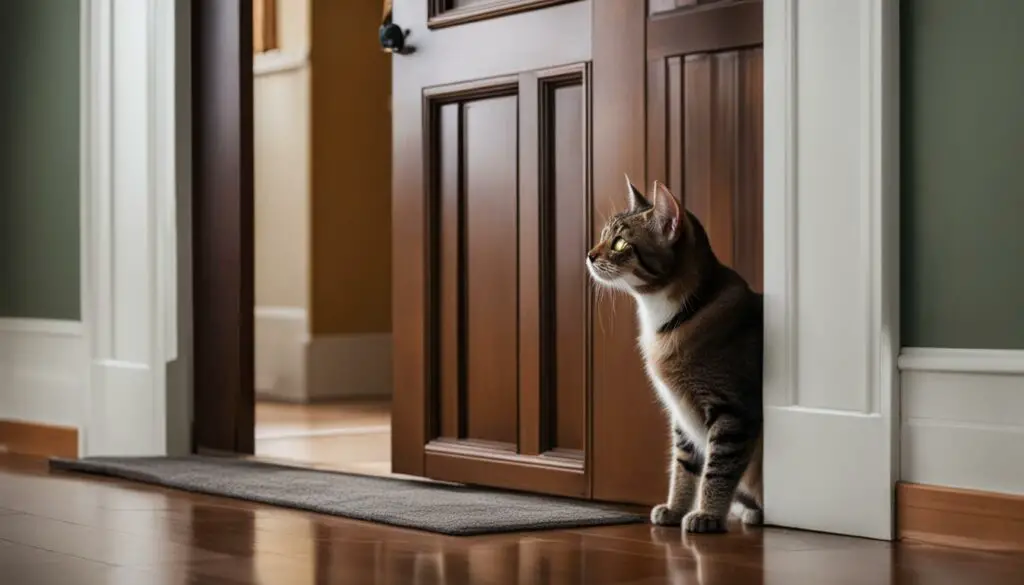
By understanding the causes of cat separation anxiety, we can take proactive steps to create a supportive environment for our cats and help alleviate their distress. It’s always recommended to consult with a veterinarian or professional behaviorist for personalized advice and guidance on managing separation anxiety in cats.
Symptoms of Separation Anxiety in Cats
Recognizing the symptoms of separation anxiety in cats is crucial for understanding and addressing their emotional well-being. Here are some common signs to look out for:
- Excessive vocalization: Cats with separation anxiety may meow excessively or make other loud noises as a way to express their distress and seek attention.
- Destructive behavior: Cats experiencing separation anxiety often engage in destructive behaviors, such as scratching furniture, chewing on objects, or urinating outside the litter box, as a way to cope with their anxiety.
- Inappropriate elimination habits: Cats with separation anxiety may urinate or defecate outside the litter box, possibly as a result of stress or a cry for attention.
- Loss of appetite: Some cats may experience a decrease in their appetite when they are separated from their owners, as they may feel too anxious or stressed to eat.
- Pacing and restlessness: Cats with separation anxiety may exhibit a restless behavior, constantly pacing, or wandering around the house as they search for their owner.
- Excessive grooming: Anxious cats often engage in overgrooming themselves, causing skin irritation or even bald patches, as a way to self-soothe and alleviate their anxiety.
- Overattachment: Cats with separation anxiety may become overly attached to their owners, following them around the house or constantly seeking physical contact.
- Habitual hiding: Some cats may retreat to hiding spots, such as under furniture or in closets, as a way to cope with their anxiety and create a sense of security.
It’s important to note that the intensity and duration of these symptoms may vary from cat to cat. If you notice any of these signs in your furry friend, it’s best to consult with a veterinarian for proper evaluation and guidance.
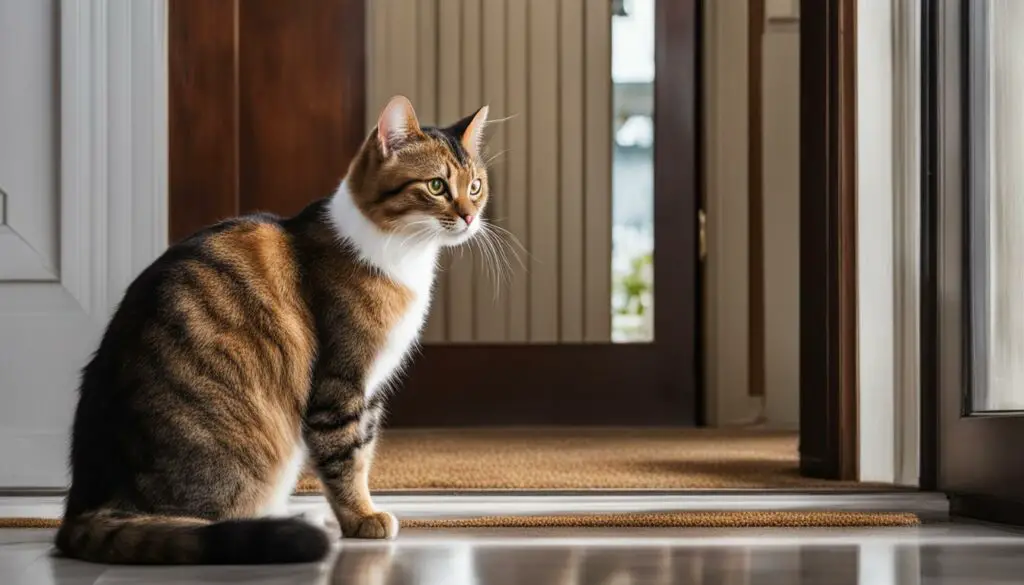
Table: Comparison of Symptoms of Separation Anxiety in Cats
| Common Symptoms | Frequency | Severity |
|---|---|---|
| Excessive vocalization | High | Moderate |
| Destructive behavior | Moderate | High |
| Inappropriate elimination habits | Moderate | High |
| Loss of appetite | Low | Low |
| Pacing and restlessness | High | Moderate |
| Excessive grooming | Moderate | Moderate |
| Overattachment | Moderate | Moderate |
| Habitual hiding | Low | Low |
How to Help a Cat With Separation Anxiety
If your cat is experiencing separation anxiety, there are several techniques you can implement to help alleviate their distress. Creating a cozy space for your cat can provide them with a sense of security and comfort. Place a soft bed or blanket in a quiet area of your home where your cat can retreat to when they are feeling anxious. Adding familiar scents, such as a worn t-shirt or a blanket with your scent, can also help them feel more at ease.
In addition to creating a cozy space, it’s important to de-dramatize goodbyes and hellos. When leaving or returning home, try to stay calm and avoid making a big fuss. This can help minimize anxiety triggers for your cat. Instead, establish a consistent routine with brief goodbyes and hellos, focusing on providing your cat with attention and affection during non-departure times.
Mental stimulation and quality playtime can also play a significant role in alleviating separation anxiety. Provide your cat with interactive toys, puzzle feeders, and engaging activities that can occupy their time and keep their minds stimulated. Regular play sessions can help redirect their focus and energy, reduce stress, and prevent boredom.
If your cat’s separation anxiety is severe or persists despite your efforts, seeking advice from a veterinarian or professional behaviorist is recommended. They can provide further guidance tailored to your cat’s specific needs and may suggest additional strategies or therapies to help manage their anxiety effectively.
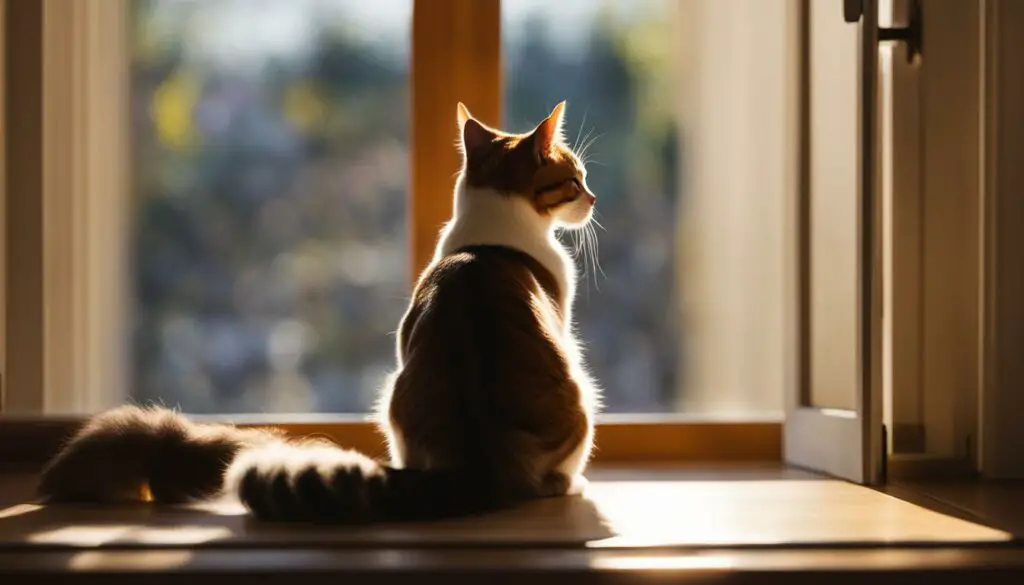
Quotes:
“Creating a cozy and comforting environment for your cat, along with de-dramatizing departures and arrivals, can go a long way in helping them cope with separation anxiety.”
Tips to Help a Cat With Separation Anxiety:
- Create a cozy space with a comfortable bed or blanket.
- De-dramatize goodbyes and hellos to minimize anxiety triggers.
- Provide mental stimulation through interactive toys and puzzles.
- Engage in regular playtime sessions with your cat.
- Seek advice from a veterinarian or professional behaviorist if needed.
Seek Your Vet’s Wisdom
If you suspect that your cat is experiencing separation anxiety, it’s important to seek veterinary advice. A veterinarian can help diagnose the anxiety and rule out any underlying medical conditions that may be contributing to your cat’s distress.
During your veterinary visit, be prepared to discuss your cat’s behavior and any signs of anxiety you have observed. The veterinarian may conduct a physical examination and ask questions about your cat’s daily routine and environment.
Based on the assessment, your veterinarian will be able to provide guidance on behavior modification techniques tailored to your cat’s specific needs. They may recommend environmental enrichment strategies, such as providing interactive toys and creating safe spaces for your cat to retreat to. In some cases, medication may be prescribed to help alleviate your cat’s anxiety.
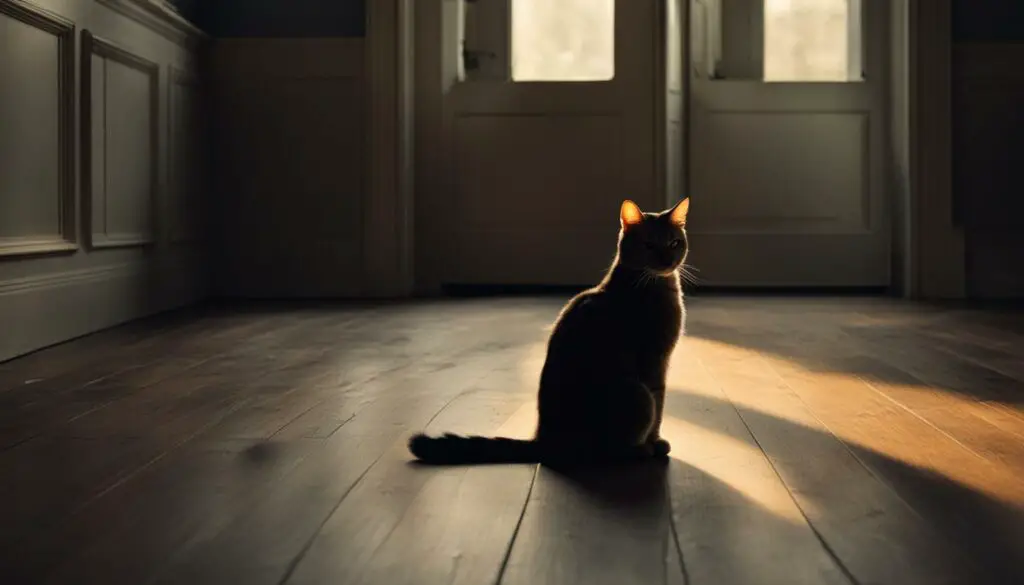
Remember, your veterinarian is an essential partner in your cat’s healthcare journey and can provide valuable insights and support in managing separation anxiety.
Tips and Resources to Help Cats With Separation Anxiety
If your cat is experiencing separation anxiety, there are several tips and resources available to help create a more calm and comfortable environment for them. Here are some strategies you can try:
1. Create a Cozy Space
Set up a designated area in your home where your cat can retreat to when they’re feeling anxious or overwhelmed. This space should be quiet, comfortable, and equipped with cozy bedding. Adding familiar scents, such as a blanket or article of your clothing, can also provide a sense of security.
2. Provide Mental Stimulation
Engaging your cat’s mind with interactive toys, puzzle feeders, and scratching posts can help distract them from their anxiety and provide mental stimulation. Rotate the toys regularly to keep them new and exciting. Additionally, incorporating playtime into your daily routine can help keep your cat physically and mentally active.
3. Gradual Training for Alone Time
Help your cat feel more comfortable with being alone by gradually increasing the duration of separation. Start with short periods of time and gradually extend them, using positive reinforcement techniques. Reward your cat with treats or praise when they remain calm during these training sessions.
4. Utilize Resources and Tools
There are various resources available to assist with managing cat separation anxiety. Pheromone diffusers, such as Feliway, release synthetic pheromones that can help create a calming environment. Additionally, consider consulting with a professional behaviorist who specializes in cat behavior for personalized advice and guidance.
Remember, every cat is unique, so it may take some trial and error to find the strategies that work best for your furry friend. Patience, consistency, and a calm approach are key when helping cats overcome separation anxiety.
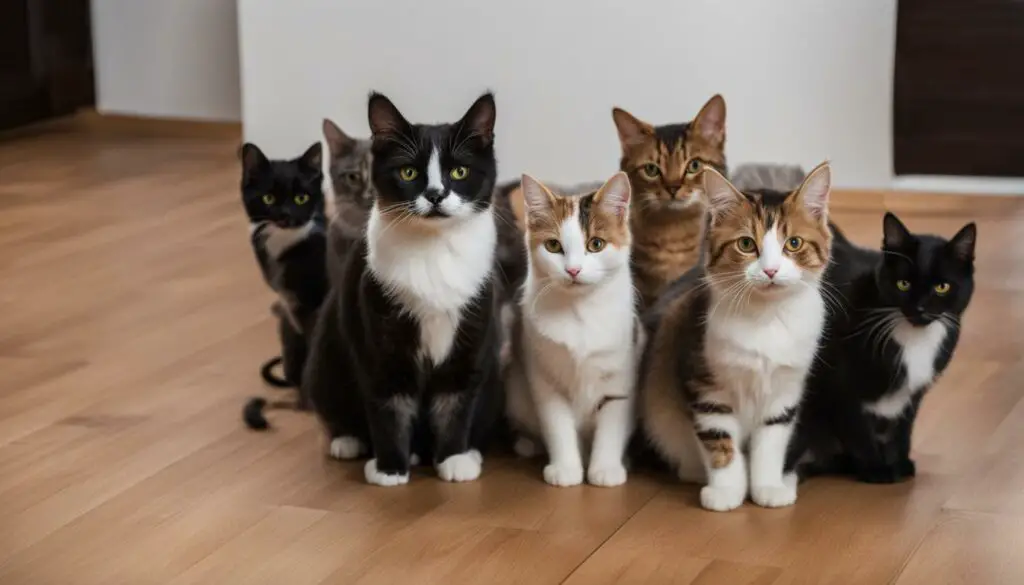
Conclusion
In conclusion, cat separation anxiety is a real and distressing condition that can affect cats of all ages. It is important for cat owners to understand the signs and causes of separation anxiety in order to provide the necessary support and help alleviate their cats’ anxiety.
Recognizing the symptoms of separation anxiety, such as excessive vocalization, destructive behavior, and loss of appetite, is the first step in addressing the issue. Creating a cozy and comfortable space, providing mental stimulation, and gradually acclimating cats to being alone can help ease their anxiety and promote a sense of security.
Seeking advice from a veterinarian or professional behaviorist is crucial in managing cat separation anxiety. They can provide guidance on behavioral modification techniques and, if necessary, prescribe medication to help alleviate the symptoms. Additional resources and tools, such as treat-dispensing gadgets and pheromone diffusers, can also aid in managing the anxiety.
By understanding and addressing cat separation anxiety, we can create a more calm and reassuring environment for our feline friends. With proper support and care, cats can thrive and feel more confident even when left alone. Remember, you are not alone in this journey, and there are resources available to help you and your cat through this challenging time.
FAQ
Can cats experience separation anxiety?
Yes, cats can experience separation anxiety, although it may be less noticeable compared to dogs.
What are the signs of cat separation anxiety?
Signs of cat separation anxiety can include excessive meowing, clinginess, hiding, fear, and urinating or defecating outside the litter box.
What causes cat separation anxiety?
Cat separation anxiety can be caused by various factors, including early weaning, genetics, change or lack of stimuli, and health issues.
How can cat separation anxiety be treated?
Treatment for cat separation anxiety can include behavioral modification techniques and, in severe cases, medication prescribed by a veterinarian.
Are kittens more prone to separation anxiety?
Yes, kittens that were separated from their mother too soon or had a lack of socialization may be more prone to separation anxiety.
Do cats cry when left alone due to separation anxiety?
Yes, cats may cry when left alone due to separation anxiety.
How can I monitor my cat when I’m away?
Pet cameras allow you to keep an eye on your cat and even interact with them through voice and treat dispensing features.
Can cats get separation anxiety according to experts?
Yes, experts confirm that cats can develop separation-related problems and exhibit signs of anxiety when left alone.
What exactly is cat separation anxiety?
Cat separation anxiety is a stress response observed when cats are separated from someone or another animal they are strongly bonded to, such as their owner.
What are the causes of cat separation anxiety?
The causes of cat separation anxiety are believed to be a combination of environmental and hereditary factors, with changes in routines and lack of socialization also contributing to the condition.
What are the symptoms of separation anxiety in cats?
Symptoms of separation anxiety in cats can include excessive vocalization, destructive behavior, inappropriate elimination habits, loss of appetite, pacing and restlessness, excessive grooming, overattachment, and habitual hiding.
How can I help a cat with separation anxiety?
You can help a cat with separation anxiety by creating a cozy space for them, de-dramatize goodbyes and hellos, providing treats, toys, mental stimulation, and quality playtime, and seeking advice from a veterinarian or professional behaviorist if needed.
When should I seek veterinary advice for cat separation anxiety?
If your cat is showing signs of separation anxiety, it’s important to consult with a veterinarian. They can help diagnose the anxiety and rule out any underlying medical conditions.
What are some tips and resources to help cats with separation anxiety?
Some tips and resources to help cats with separation anxiety include creating a cozy space, providing mental stimulation, and training your cat to be more comfortable with alone time. Utilizing tools such as treat-dispensing gadgets, pheromone diffusers, and professional behaviorists can also aid in managing separation anxiety in cats.

